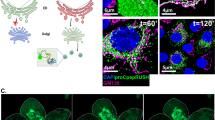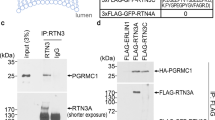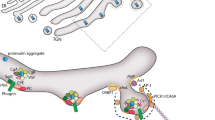Abstract
Transthyretin (TTR) is a functional protein in the pancreatic β-cell. It promotes insulin release and protects against β-cell death. We now demonstrate by ligand blotting, adsorption to specific magnetic beads, and surface plasmon resonance that TTR binds to glucose-regulated proteins (Grps)78, 94, and 170, which are members of the endoplasmic reticulum chaperone family, but Grps78 and 94 have also been found at the plasma membrane. The effect of TTR on changes in cytoplasmic free Ca2+ concentration ([Ca2+]i) was abolished if the cells were treated with either dynasore, a specific inhibitor of dynamin GTPase that blocks clathrin-mediated endocytosis, or an antibody against Grp78, that prevents TTR from binding to Grp78. The conclusion is that TTR binds to Grp78 at the plasma membrane, is internalized into the β-cell via a clathrin-dependent pathway, and that this internalization is necessary for the effects of TTR on β-cell function.






Similar content being viewed by others
References
Blake CC (1981) Prealbumin and the thyroid hormone nuclear receptor. Proc R Soc Lond B Biol Sci 211:413–431
Jacobsson B, Carlström A, Platz A, Collins VP (1990) Transthyretin messenger ribonucleic acid expression in the pancreas and in endocrine tumors of the pancreas and gut. J Clin Endocrinol Metab 71:875–880
Itoh N, Hanafusa T, Miyagawa J, Tamura S, Inada M, Kawata S, Kono N, Tarui S (1992) Transthyretin (prealbumin) in the pancreas and sera of newly diagnosed type I (insulin-dependent) diabetic patients. J Clin Endocrinol Metab 74:1372–1377
Refai E, Dekki N, Yang SN, Imreh G, Cabrera O, Yu L, Yang G, Norgren S, Rossner SM, Inverardi L, Ricordi C, Olivecrona G, Andersson M, Jörnvall H, Berggren PO, Juntti-Berggren L (2005) Transthyretin constitutes a functional component in pancreatic beta-cell stimulus-secretion coupling. Proc Natl Acad Sci USA 102:17020–17025
Juntti-Berggren L, Refai E, Appelskog I, Andersson M, Imreh G, Dekki N, Uhles S, Yu L, Griffiths WJ, Zaitsev S, Leibiger I, Yang SN, Olivecrona G, Jörnvall H, Berggren PO (2004) Apolipoprotein CIII promotes Ca2+-dependent beta cell death in type 1 diabetes. Proc Natl Acad Sci USA 101:10090–10094
Divino CM, Schussler GC (1990) Receptor-mediated uptake and internalization of transthyretin. J Biol Chem 265:1425–1429
Divino CM, Schussler GC (1990) Transthyretin receptors on human astrocytoma cells. J Clin Endocrinol Metab 71:1265–1268
Vieira AV, Sanders EJ, Schneider WJ (1995) Transport of serum transthyretin into chicken oocytes. A receptor-mediated mechanism. J Biol Chem 270:2952–2956
Kuchler-Bopp S, Dietrich JB, Zaepfel M, Delaunoy JP (2000) Receptor-mediated endocytosis of transthyretin by ependymoma cells. Brain Res 870:185–194
Sousa MM, Saraiva MJ (2001) Internalization of transthyretin. Evidence of a novel yet unidentified receptor-associated protein (RAP)-sensitive receptor. J Biol Chem 276:14420–14425
Lernmark A (1974) The preparation of, and studies on, free cell suspensions from mouse pancreatic islets. Diabetologia 10:431–438
Hirschberg D, Tryggvason S, Gustafsson M, Bergman T, Swedenborg J, Hedin U, Jörnvall H (2004) Identification of endothelial proteins by MALDI-MS using a compact disc microfluidic system. Protein J 23:263–271
Hammond TG, Verroust PJ (1994) Trafficking of apical proteins into clathrin-coated vesicles isolated from rat renal cortex. Am J Physiol 266:554–562
Macia E, Ehrlich M, Massol R, Boucrot E, Brunner C, Kirchhausen T (2006) Dynasore, a cell-permeable inhibitor of dynamin. Dev Cell 10:839–850
Vieira AV, Schneider WJ (1993) Transport and uptake of retinol during chicken oocyte growth. Biochim Biophys Acta 1169:250–256
Hussain MM, Strickland DK, Bakillah A (1999) The mammalian low-density lipoprotein receptor family. Annu Rev Nutr 19:141–172
Sousa MM, Norden AG, Jacobsen C, Willnow TE, Christensen EI, Thakker RV, Verroust PJ, Moestrup SK, Saraiva MJ (2000) Evidence for the role of megalin in renal uptake of transthyretin. J Biol Chem 275:38176–38181
Fleming CE, Mar FM, Franquinho F, Saraiva MJ, Sousa MM (2009) Transthyretin internalization by sensory neurons is megalin mediated and necessary for its neuritogenic activity. J Neurosci 29:3220–3232
Chang MH, Hua CT, Isaac EL, Litjens T, Hodge G, Karageorgos LE, Meikle PJ (2004) Transthyretin interacts with the lysosome-associated membrane protein (LAMP-1) in circulation. Biochem J 382:481–489
Ni M, Lee AS (2007) ER chaperones in mammalian development and human diseases. FEBS Lett 581:3641–3651
Lee AS (1992) Mammalian stress response: induction of the glucose-regulated protein family. Curr Opin Cell Biol 4:267–273
Villa A, Podini P, Clegg DO, Pozzan T, Meldolesi J (1991) Intracellular Ca2+ stores in chicken Purkinje neurons: differential distribution of the low affinity-high capacity Ca2+ binding protein, calsequestrin, of Ca2+ ATPase and of the ER lumenal protein, Bip. J Cell Biol 113:779–791
Lievremont JP, Rizzuto R, Hendershot L, Meldolesi J (1997) BiP, a major chaperone protein of the endoplasmic reticulum lumen, plays a direct and important role in the storage of the rapidly exchanging pool of Ca2+. J Biol Chem 272:30873–30879
Macer DR, Koch GL (1988) Identification of a set of calcium-binding proteins in reticuloplasm, the luminal content of the endoplasmic reticulum. J Cell Sci 91(Pt 1):61–70
Liu H, Miller E, van de Water B, Stevens JL (1998) Endoplasmic reticulum stress proteins block oxidant-induced Ca2+ increases and cell death. J Biol Chem 273:12858–12862
McCormick TS, McColl KS, Distelhorst CW (1997) Mouse lymphoma cells destined to undergo apoptosis in response to thapsigargin treatment fail to generate a calcium-mediated grp78/grp94 stress response. J Biol Chem 272:6087–6092
Miyake H, Hara I, Arakawa S, Kamidono S (2000) Stress protein GRP78 prevents apoptosis induced by calcium ionophore, ionomycin, but not by glycosylation inhibitor, tunicamycin, in human prostate cancer cells. J Cell Biochem 77:396–408
Morris JA, Dorner AJ, Edwards CA, Hendershot LM, Kaufman RJ (1997) Immunoglobulin binding protein (BiP) function is required to protect cells from endoplasmic reticulum stress but is not required for the secretion of selective proteins. J Biol Chem 272:4327–4334
Reddy RK, Mao C, Baumeister P, Austin RC, Kaufman RJ, Lee AS (2003) Endoplasmic reticulum chaperone protein GRP78 protects cells from apoptosis induced by topoisomerase inhibitors: role of ATP binding site in suppression of caspase-7 activation. J Biol Chem 278:20915–20924
Kang HS, Welch WJ (1991) Characterization and purification of the 94-kDa glucose-regulated protein. J Biol Chem 266:5643–5649
Lin HY, Masso-Welch P, Di YP, Cai JW, Shen JW, Subjeck JR (1993) The 170-kDa glucose-regulated stress protein is an endoplasmic reticulum protein that binds immunoglobulin. Mol Biol Cell 4:1109–1119
Melnick J, Aviel S, Argon Y (1992) The endoplasmic reticulum stress protein GRP94, in addition to BiP, associates with unassembled immunoglobulin chains. J Biol Chem 267:21303–21306
Meunier L, Usherwood YK, Chung KT, Hendershot LM (2002) A subset of chaperones and folding enzymes form multiprotein complexes in endoplasmic reticulum to bind nascent proteins. Mol Biol Cell 13:4456–4469
Chang L, Munro SL, Richardson SJ, Schreiber G (1999) Evolution of thyroid hormone binding by transthyretins in birds and mammals. Eur J Biochem 259:534–542
Goncalves I, Quintela T, Baltazar G, Almeida MR, Saraiva MJ, Santos CR (2008) Transthyretin interacts with metallothionein 2. Biochemistry 47:2244–2251
Zanotti G, Folli C, Cendron L, Alfieri B, Nishida SK, Gliubich F, Pasquato N, Negro A, Berni R (2008) Structural and mutational analyses of protein–protein interactions between transthyretin and retinol-binding protein. Febs J 275:5841–5854
Sorgjerd K, Ghafouri B, Jonsson BH, Kelly JW, Blond SY, Hammarstrom P (2006) Retention of misfolded mutant transthyretin by the chaperone BiP/GRP78 mitigates amyloidogenesis. J Mol Biol 356:469–482
Susuki S, Sato T, Miyata M, Momohara M, Suico MA, Shuto T, Ando Y, Kai H (2009) The Endoplasmic reticulum-associated degradation of transthyretin variants is negatively regulated by BiP in mammalian cells. J Biol Chem 284:8312–8321
Arap MA, Lahdenranta J, Mintz PJ, Hajitou A, Sarkis AS, Arap W, Pasqualini R (2004) Cell surface expression of the stress response chaperone GRP78 enables tumor targeting by circulating ligands. Cancer Cell 6:275–284
Calvert ME, Digilio LC, Herr JC, Coonrod SA (2003) Oolemmal proteomics–identification of highly abundant heat shock proteins and molecular chaperones in the mature mouse egg and their localization on the plasma membrane. Reprod Biol Endocrinol 1:27
de Crom R, van Haperen R, Janssens R, Visser P, Willemsen R, Grosveld F, van der Kamp A (1999) Gp96/GRP94 is a putative high-density lipoprotein-binding protein in liver. Biochim Biophys Acta 1437:378–392
Delpino A, Castelli M (2002) The 78 kDa glucose-regulated protein (GRP78/BIP) is expressed on the cell membrane, is released into cell culture medium and is also present in human peripheral circulation. Biosci Rep 22:407–420
Reddy RK, Lu J, Lee AS (1999) The endoplasmic reticulum chaperone glycoprotein GRP94 with Ca(2 +)-binding and antiapoptotic properties is a novel proteolytic target of calpain during etoposide-induced apoptosis. J Biol Chem 274:28476–28483
Robert J, Menoret A, Cohen N (1999) Cell surface expression of the endoplasmic reticular heat shock protein gp96 is phylogenetically conserved. J Immunol 163:4133–4139
Triantafilou M, Fradelizi D, Triantafilou K (2001) Major histocompatibility class one molecule associates with glucose regulated protein (GRP) 78 on the cell surface. Hum Immunol 62:764–770
Wiest DL, Bhandoola A, Punt J, Kreibich G, McKean D, Singer A (1997) Incomplete endoplasmic reticulum (ER) retention in immature thymocytes as revealed by surface expression of “ER-resident” molecular chaperones. Proc Natl Acad Sci USA 94:1884–1889
Misra UK, Gonzalez-Gronow M, Gawdi G, Hart JP, Johnson CE, Pizzo SV (2002) The role of Grp 78 in alpha 2-macroglobulin-induced signal transduction. Evidence from RNA interference that the low-density lipoprotein receptor-related protein is associated with, but not necessary for, GRP 78-mediated signal transduction. J Biol Chem 277:42082–42087
Misra UK, Gonzalez-Gronow M, Gawdi G, Wang F, Pizzo SV (2004) A novel receptor function for the heat shock protein Grp78: silencing of Grp78 gene expression attenuates alpha2 M*-induced signalling. Cell Signal 16:929–938
Brown MS, Goldstein JL (1986) A receptor-mediated pathway for cholesterol homeostasis. Science 232:34–47
Brodsky FM, Chen CY, Knuehl C, Towler MC, Wakeham DE (2001) Biological basket weaving: formation and function of clathrin-coated vesicles. Annu Rev Cell Dev Biol 17:517–568
Goldstein JL, Anderson RG, Brown MS (1979) Coated pits, coated vesicles, and receptor-mediated endocytosis. Nature 279:679–685
Trowbridge IS, Collawn JF, Hopkins CR (1993) Signal-dependent membrane protein trafficking in the endocytic pathway. Annu Rev Cell Biol 9:129–161
Smith SS, Pino RM, Thouron CL (1989) Binding and transport of transthyretin-gold by the endothelium of the rat choriocapillaris. J Histochem Cytochem 37:1497–1502
Acknowledgments
We thank Prof Tomas Kirchhausen, Harvard Medical School, who kindly provided us with dynasore, synthesized by Dr Henry E Pelish. This work was supported by grants from The Family Erling-Persson Foundation, The Swedish Research Council, the Novo Nordisk Foundation, Swedish Diabetes Association, Barndiabetesfonden, Karolinska Institutet, Magnus Bergwalls Foundation, The Knut and Alice Wallenberg Foundation, the Skandia Insurance Company Ltd., VIBRANT (FP7-228933-2), Strategic Research Program in Diabetes at Karolinska Institutet and Berth von Kantzow’s Foundation.
Author information
Authors and Affiliations
Corresponding author
Rights and permissions
About this article
Cite this article
Dekki, N., Refai, E., Holmberg, R. et al. Transthyretin binds to glucose-regulated proteins and is subjected to endocytosis by the pancreatic β-cell. Cell. Mol. Life Sci. 69, 1733–1743 (2012). https://doi.org/10.1007/s00018-011-0899-8
Received:
Revised:
Accepted:
Published:
Issue Date:
DOI: https://doi.org/10.1007/s00018-011-0899-8




